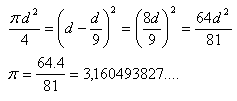Ludolf's number in antiquity
Every pupil or student has often encountered the task of calculating the circumference of a circle, the area of a circle, the volume and surface of a sphere, etc. In such tasks, Ludolph’s number π appears, which expresses the ratio of the circumference of a circle to its diameter. The number π is an irrational number, which means that it cannot be expressed as a ratio of two integers. Nevertheless, many mathematicians throughout history have attempted to do so. The number π is transcendental, which means that it is not the solution to any algebraic equation with rational coefficients.
It is called Ludolph’s number in honor of the Dutchman Ludolph van Ceulen (1540–1610), who in 1596 calculated this number to 35 decimal places.
The symbol π was introduced by the English mathematician William Jones (1675–1749) as the first letter of the word “periphery” – circumference. The symbol π gained worldwide recognition only when it began to be used in the works of the distinguished 18th-century mathematician L. Euler (1707–1783).
Throughout the history of mathematics, various values have been used for π. Let’s take a look at just a few examples. During archaeological excavations in Babylon, a clay tablet was found dating back to about 2000 B.C. with a cuneiform inscription:
 π = 3.125
π = 3.125
Around 1650 B.C., the Egyptian scribe Ahmose wrote the first textbook on algebra and geometry on a papyrus. The papyrus is known as the Rhind Papyrus, named after its Scottish owner who discovered it in 1858 in the temple of Pharaoh Ramses II in Thebes. At the beginning of the papyrus, the author describes mathematics as “a guide to obtaining knowledge of all secret things ... of all the mysteries hidden within things.”
It also contains an interesting method for calculating the area of a circle: “Do you want to know the area of a circle? Measure the distance from one side of the circle to the other. Subtract one-ninth of this distance. Multiply the resulting number by itself. The result will give you the area of your circle.” Translated into modern notation, the method for calculating the area of a circle is:

Even the Bible contains a reference to the number π. In the First Book of Kings, chapter 7, verse 23, it says of a water basin in Solomon’s palace in Jerusalem: “Then he made the sea of cast metal, ten cubits from one rim to the other, round in shape, five cubits high, and a line of thirty cubits measured its circumference.” From the text, it follows that π = 3.